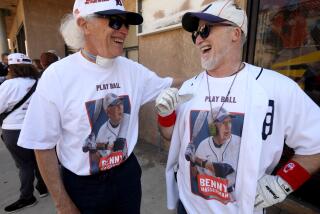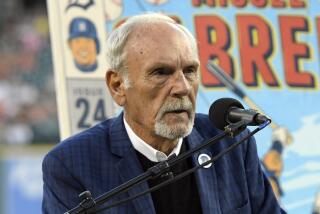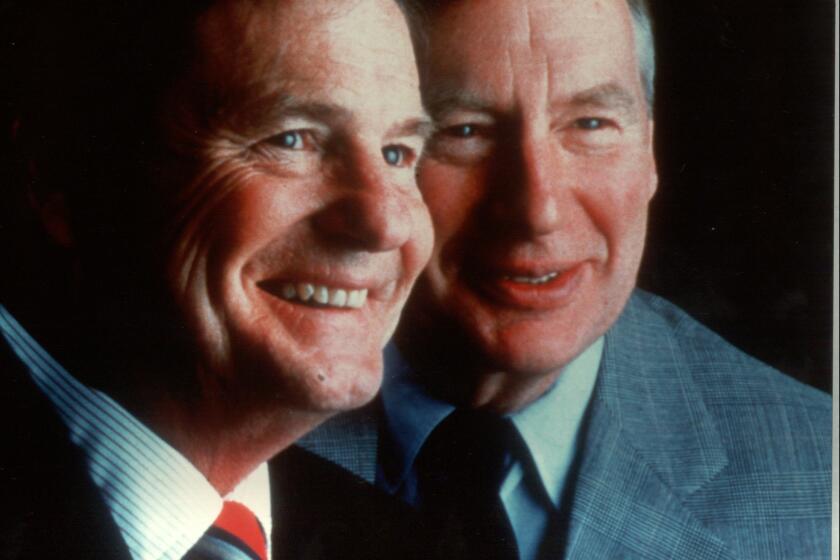Ralph Kiner dies at 91; Hall of Fame slugger with Pittsburgh Pirates
Ralph Kiner, who spent 10 seasons hitting towering home runs in the major leagues, then spent most of the rest of his life joyfully calling baseball games on radio and TV, died Thursday at his home in Rancho Mirage, Calif. He was 91.
The Baseball Hall of Fame announced his death, citing natural causes.
An outfielder, Kiner played for three clubs — he was a shining star for the otherwise dreary Pittsburgh Pirates in the late 1940s and early ‘50s — but New York fans knew him as the funny guy who broadcast Mets games for more than 40 years, mixing up the players’ names and goofing up the language.
Kiner loved home runs as a player — he hit 369 of them in his Hall of Fame career and was quick to point out, “If you can’t hit a home run, where’s the fun in baseball?” — and he loved them as a broadcaster, whose signature long-ball call was: “Going, going, gone, goodbye.”
His broadcasts were marked by “slips” — Gary Carter became Gary Cooper, Darryl Strawberry morphed into Marv Throneberry, Dwight Gooden was Greg Goossen — and Kinerisms: “If Casey Stengel were alive today, he’d be spinning in his grave.” “Solo homers usually come with no one on base.” “History is over.”
Whatever criticism came his way, the easygoing Kiner brushed it off, acknowledging that some of his Kinerisms were well-considered and used for effect. In any event, his broadcasting work earned him an Emmy and the admiration of his boss, longtime Mets owner Fred Wilpon, who once told Newsday: “No one knows more about baseball than Ralph Kiner.”
And if hitting home runs was the most fun for Kiner, describing them on TV was a close second. “I enjoy being at the ballpark,” he said. “I get the best seat in the house and I get paid to do it. It is as good as you can get.”
It was as good as it could get for Kiner as a player, too. World War II was just over and many ballplayers, including Kiner, were back from service. Baseball, watered down during the war years, was looking at brighter horizons. The New York Yankees had Joe DiMaggio back, the Boston Red Sox had Ted Williams back, the St. Louis Cardinals had Stan Musial back and the New York Giants had Johnny Mize back, home run hitters all.
But the Pirates, the lowly Pittsburgh Pirates, had Kiner. Had they not, the franchise might have sunk out of sight because Kiner, basically, was all they had. There was no protection for him in the batting order and the Pirates’ pitching was, at best, mediocre. In his seven seasons in Pittsburgh, the Pirates never finished higher than fourth in the eight-team National League and most seasons they were fighting to stay out of the cellar. In 1952, Kiner’s last full season with the Pirates, the team finished last with a 42-112 record, 541/2 games out of first.
Kiner, though, with his big bat, was a drawing card. Fans in record numbers flocked to old Forbes Field to watch him launch his majestic shots, and the Kiner years were profitable years. It didn’t matter that most fans left after his final at-bat; they’d paid to get in and would be back for more.
More was always coming too, for Kiner not only hit home runs, he hit them reliably.
For seven consecutive seasons, he won or shared the National League homer title. Twice, he hit more than 50 — 51 in 1947 and 54 in 1949, when he also led the league in runs batted in with 127. From 1947 through 1951, he hit more than 40 home runs a season, averaging nearly 47 and 121 RBIs. And although he struck out often, as home run hitters tend to do, it wasn’t always a case of home run or nothing with Kiner. He hit better than .300 three times and finished his playing career with a .279 batting average.
Born Oct. 27, 1922, in Santa Rita, N.M., a town that no longer exists, Kiner grew up in Southern California. His father, a baker, died when he was 4 and his mother brought him to the Los Angeles area. Kiner graduated from Alhambra High School and, at 18, signed with the Pirates for a $3,000 bonus and a promise of $5,000 more when he made the majors. He attended what was then called Pasadena Junior College during his minor league years, then was drafted in 1943 and served for two years in the Navy.
Discharged in 1945, he appeared destined for another season in the minors but hit 14 home runs in spring training of ’46. Manager Frankie Frisch, desperate for talent, added him to the Pirates roster. Kiner responded by hitting a league-high 23 homers as a rookie.
By the early ‘50s, Kiner was among baseball’s highest-paid players, making $90,000 a season, but the Pirates by then had hired cost-conscious Branch Rickey as their general manager. Rickey told Kiner after the 1952 season that the slugger would have to take a pay cut. When Kiner pointed out that he had led the league in home runs, again, Rickey replied: “We finished last with you. We can finish last without you.”
And four games into the ’53 season, Kiner was traded to the Chicago Cubs in a 10-player deal. He spent two seasons in Chicago, then finished with the Cleveland Indians in 1955, stepping aside at 32 with recurring back problems.
He began his broadcasting career with the Chicago White Sox in 1961, then moved on to the expansion Mets the next year and settled in, still calling several games a season late in life, including last year.
In his playing days, Kiner enjoyed a Hollywood lifestyle, dating actresses Janet Leigh and Elizabeth Taylor before marrying tennis star Nancy Chaffee. Their marriage ended in divorce, as did his second, to Barbara George. His third wife, DiAnn Shugart, died in 2004.
Kiner is survived by sons Ralph Michael Kiner and Scott McPherran Kiner; daughters Kathryn Chaffee Freeman, Tracey Jansen and Kimberlee Manzoni; and 12 grandchildren.
Kupper is a former Times staff writer.
More to Read
Start your day right
Sign up for Essential California for the L.A. Times biggest news, features and recommendations in your inbox six days a week.
You may occasionally receive promotional content from the Los Angeles Times.






